 The climate may be changing, but we still have winter. Gardeners in intemperate climes must know their planting “zone” and the projected date of the last frost to take full advantage of their abbreviated growing seasons. When is it safe for you to plant? Click on “Frost /Freeze Data 1971-2001” to use the widget from NESDIS, the National Environmental Satellite, Data and Information Service, which will find station freeze/ frost probability tables for your state.
The climate may be changing, but we still have winter. Gardeners in intemperate climes must know their planting “zone” and the projected date of the last frost to take full advantage of their abbreviated growing seasons. When is it safe for you to plant? Click on “Frost /Freeze Data 1971-2001” to use the widget from NESDIS, the National Environmental Satellite, Data and Information Service, which will find station freeze/ frost probability tables for your state.
http://cdo.ncdc.noaa.gov/cgi-bin/climatenormals/climatenormals.pl



